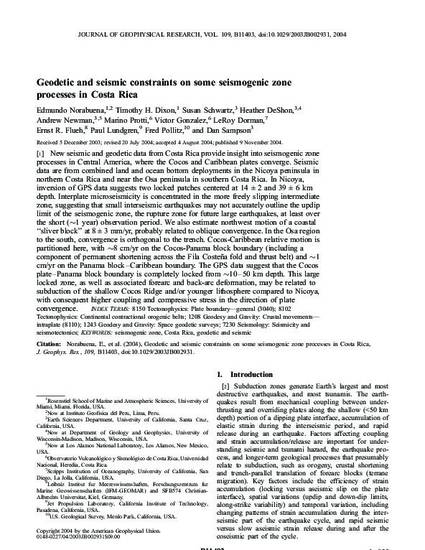
- seismogenic zone,
- Costa Rica,
- geodetic and seismic
New seismic and geodetic data from Costa Rica provide insight into seismogenic zone processes in Central America, where the Cocos and Caribbean plates converge. Seismic data are from combined land and ocean bottom deployments in the Nicoya peninsula in northern Costa Rica and near the Osa peninsula in southern Costa Rica. In Nicoya, inversion of GPS data suggests two locked patches centered at 14 ± 2 and 39 ± 6 km depth. Interplate microseismicity is concentrated in the more freely slipping intermediate zone, suggesting that small interseismic earthquakes may not accurately outline the updip limit of the seismogenic zone, the rupture zone for future large earthquakes, at least over the short (∼1 year) observation period. We also estimate northwest motion of a coastal “sliver block” at 8 ± 3 mm/yr, probably related to oblique convergence. In the Osa region to the south, convergence is orthogonal to the trench. Cocos‐Caribbean relative motion is partitioned here, with ∼8 cm/yr on the Cocos‐Panama block boundary (including a component of permanent shortening across the Fila Costeña fold and thrust belt) and ∼1 cm/yr on the Panama block–Caribbean boundary. The GPS data suggest that the Cocos plate–Panama block boundary is completely locked from ∼10–50 km depth. This large locked zone, as well as associated forearc and back‐arc deformation, may be related to subduction of the shallow Cocos Ridge and/or younger lithosphere compared to Nicoya, with consequent higher coupling and compressive stress in the direction of plate convergence.
Journal of Geophysical Research, v. 109, issue B11, art. B11403
Copyright 2004 by the American Geophysical Union.
Available at: http://works.bepress.com/timothydixon/63/
